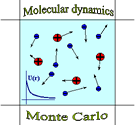Principles of our sustained development
I. Our research group is a division of JIHT RAS. We work in atomistic modeling and simulation. Subject area includes both (1) general problems and (2) applications.
(1) General problems, common for diverse applications, are: theory of classical and quantum atomistic (molecular) modeling, related problems of supercomputer simulation and high performance computing information technologies. Multi-scale approaches are particular issues based on the theoretical physics.
(2) Diverse applications are taken from condense matter and plasma physics, molecular and biochemical physics, electrochemistry and electrophysics, nanothechnologies etc. The issues are similar to those of the one third of the INCITE projects.
Becoming proficient in different approaches to the Newton & Schroedinger equations numerical solutions, we extend the range of applied topics adjusted to new supercomputers available.
Extension of the research topics requires extension of the researcher number. To be prepared in advance we try to invite new students every year. The division has been developing for account originally of Norman's pupils but now of Stegailov's pupils as well. Senior staff scientists are also encouraged to look for pupils.
II. A particular learn-by-doing system is developed to combine research and teaching. Its distinctive features are:
a) early start of the scientific work at the third, second or even first year of specially selected talented students;
b) teaching not only how to do research but as well how to write a paper, to prepare a presentation and deliver a report at scientific conferences, first in Russian, then in English, how to write proposals for grants, applications for stipends or prizes;
c) team work and a special flexible hierarchy when senior people help juniors;
d) serious publications in peer-reviewed journals already in undergraduate studies, ahead-of-schedule presentation of a PhD thesis;
e) speeded up promotion to senior staff scientist position;
f) PhD's are encouraged to supplement their research by part-time teaching in MIPT.
The table of the Promotion steps (PDF) (that shows the data for September 2013) demonstrates the sustained results of the learn-by-doing research & teaching system (PDF). Norman had a student and two post graduate students in 2002. Now (2016) the collective consists of one more Dr.Hab., 5 Ph.D.'s, 3 post graduate students, 16 students of the 2nd, 3rd, 4th, 5th and 6th years, totally 26 collaborators.
III. Research-education-applications trinity is our development strategy.
Genri Norman
Dr. Habilitus,
Principal researcher, Joint Institute for High Temperatures of Russian Academy of Sciences
Part-time professor, Moscow Institute of Physics and Technology (State University)
| 

![]()